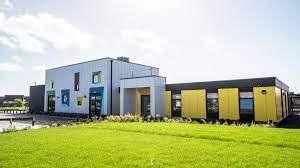Offsite construction is helping to meet the quality and cost requirements of a variety of modern buildings. Innovation within offsite construction means it is now possible to offer greater flexibility in the design of modular buildings than ever before. The offsite sector has been able to do this by introducing modern hybrid systems that offer all the advantages of conventionally built structures, but with the speed and quality of offsite construction systems. The beauty of these buildings is that they are permanent and are guaranteed to last as long as you would expect a traditionally-built structure.
One of the most significant advances in the design of such buildings has been the introduction of corner-loaded modules, which greatly increase the scope for design. These systems can also generate significant cost savings on site and throughout the lifetime of a building.
Corner loaded modules allow for the construction of more visually engaging buildings with, for example, full height glass walls. Glazed walls are now possible because of the advances we have made in panel bracing, which means that the systems can be engineered into different structural members contained within the module.
Technical developments such as these mean that offsite buildings now offer much greater design flexibility. For example, by choosing an offsite corner-loaded system, units can be supplied either fully serviced – and with watertight exterior cladding – and ready to be craned into position, or as flat pack panels where there is a site access issue, which are easily assembled and finished on site.
Hybrid offsite systems are based around a steel frame, which provides greater architectural freedom in an economical and space-efficient building. The steel frame system allows the building designer to literally break out of the box and specify modules that are non-rectangular in design or have internal atria or balconies.
For clients, this means offsite buildings are indistinguishable from traditionally-built structures. These hybrid systems also allow for full height glazed walls to be incorporated into the design – a feature that is becoming very popular in domestic and commercial buildings, as building designers look to maximise the benefits of natural daylight, for health and well being benefits.
There are other advantages of corner loaded offsite systems, such as the savings that can be made on foundation materials and therefore cost. The use of fewer foundation materials, which tend to have high embodied energy content, also results in a building with a smaller carbon footprint and that leads to significant benefits in terms of sustainability.
Many customers are looking for a seamless link with an existing traditionally-built structures. This means having to create a visual match externally, along with ensuring that internal floor heights are the same. In response to this, we adapted our corner loaded system so that floor levels could be set at any height required to suit existing floor levels, avoiding any unnecessary steps or slopes.
Exterior finishes are an important part of any offsite building and help to establish the character and context within local surroundings. The options for modular buildings are the same as those for any other type of building system, ranging from brick and cedar cladding to lightweight aggregate panels that provide variety and interest in colour and texture.
On some projects, customers are recognising that the exterior render of the modular building could be refurbished relatively easily and cost-effectively, providing a completely different, updated look to the building, whilst enhancing its performance.
